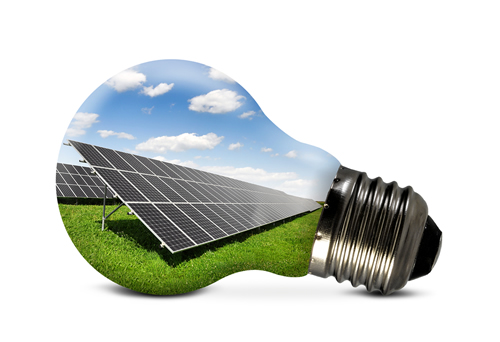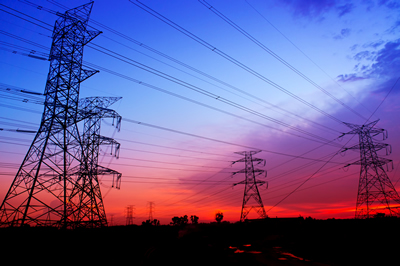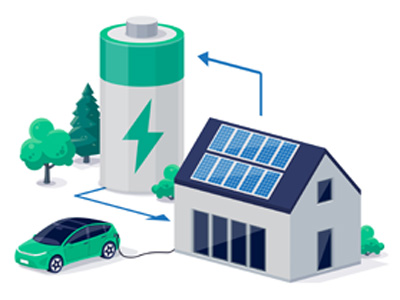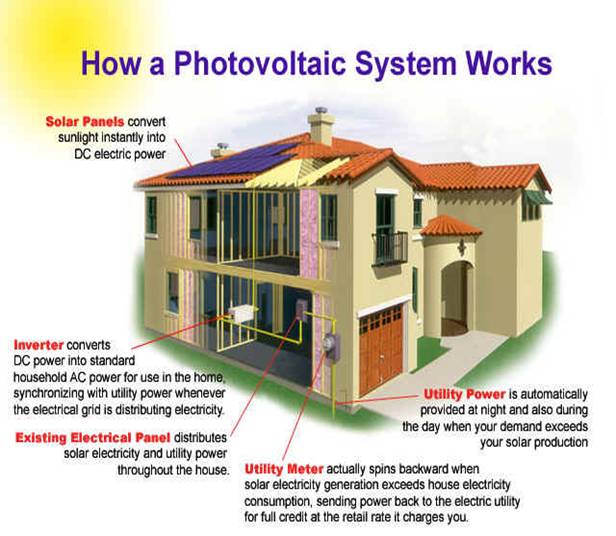
Solar energy
Taking Control Of Your Electric Bill Is Now Very Possible.
 Designing the right system for your house is important and has several key issues to consider before doing.
Designing the right system for your house is important and has several key issues to consider before doing.
Your system will either have batteries or not. Battery systems are the way of the future and the cost has dropped considerably making this possible. It is reputed that these system costs will reduce even more significantly within the next three years.
Common Residential Systems are using solar panels that called Photovoltaic type panels. We have performed the basic research and have attended a few seminars. As such, we have concluded that Home Solar Systems have come a long way and make a lot of sense for our customers. We have compiled the following information in order to give you a basic sense of what to expect from a decision to install a Solar System. It also appears that it is possible to get a 100% return on your investment within approximately eight years.
Solar energy systems have come a long way from the beginning days and are actually more affordable now than they have ever been. Good systems will increase your property value and will provide a good return on the initial investment. Home Solar Systems can generate a 125% return in 5 years, 250% return in 10 years, and 350% return in 15 years. Home Solar Systems can save anywhere from 5—100% on your energy bill.
This site below will show you the top ten companies to buy this system from. Go all the way to the bottom of the page to see the list.
https://www.solarreviews.com/solar-incentives/maryland
Solar History
Solar power can be traced back to the 3rd century B.C., at a time when Greek soldiers used Solar methods while doing battle with the Romans. With the help of Archimedes, soldiers focused light on an approaching Roman fleet of ships by using mirrors. The mirrors were focused on the ships’ sails causing them to burn and the Romans retreated quickly.
The first home solar designs were used by the Greeks, Romans, and the Egyptians to name the more popular cultures. The buildings they designed had south facing windows that were designed to allow the sun to provide both heat and light for interior spaces. Most Roman bath houses had south facing windows that heated the rooms. This kind of architecture heated homes at night while keeping the temperature low during the day. The Egyptians were also known to use the sun as part of their mummification process, using the sun to dry dead bodies. In 1767, the world's first solar collector was built by Swiss scientist Horace de Saussare.
In 1891 the first commercial solar water heater was patented by the father of American solar energy, Clarence Kemp. During the infamous 1973 – 1974 here in America, the oil embargo allowed solar power to move forward at a faster rate. The US Department of Energy funded the Federal Photovoltaic Utilization Program that started the install and testing of over 3,000 PV systems.
Solar Power Facts
The Sun is the obvious source for solar power and is the most inexhaustible, renewable source of energy known to our civilization. For solar energy to actually work to generate electricity, it must be daylight, but clouds are not as big as an issue as one might think. Solar UV rays do penetrate the clouds and photovoltaic solar panels work very well. These panels also work well in cold weather temperatures with 43 degrees Fahrenheit being the optimum operating temperature. Rain or snow is not a problem as well, but electric production will obviously be less when the Sun is not shining brightly.
The Solar panels can be mounted on your roof or on a pole that is installed in your yard. Both methods of installation are acceptable and will produce power for your home. Liberty strongly suggests the creation of a pole mounted system. Panels on the roof can be problems and they are ugly. There are several determining factors to consider. Here are a few to consider:

- Amount of roof surface
- Where does the sun rise & set
- What is your roof surface made of
- Will the panels “look good” on your roof
- How many panels will you need
- What do the initial design elements tell us
What Is "Net Metering"
This is what allows you to earn credit for the excess solar electricity that your system will produce. When your solar system produces electricity that you don’t use right away, it’s sent back to “the grid” and you get a positive credit. Your power meter will run backwards during this process. But this only one way of programming your new system.
Most modern-day solar systems are on “the grid” and do have battery backup and battery storage abilities. Batteries that store electricity are now not as expensive.
"The grid" system allows you to have electricity from your utility company, even though it’s nighttime, and your system is not producing any electricity. At night, you are using the credits you earned or you are buying electricity like normal.
Many states have strict net-metering laws that allow you to get a credit on your next utility bill if you generate more solar electricity than you use in a given month. This allows you to get the most of the power your panels produce.
What If The Power Goes Out?
If your power company loses power, then your system takes over and there is a variety of things it is programmed to do. Here again a battery system is a great choice. Our research tells us that you will need a minimum of two batteries.
How Long Will A Home Solar System Last?
Nobody really knows. Modern systems are expected to last a minimum of 25 to 30 years. Certain parts like “inverters” will need replacing, but most of the pieces of this type of system are designed to last a long time.
How Many Solar Panels Will You Need?
The amount of solar panels that you will need will depend on several factors, with initial system costs being your choice of course. The company you purchase the system from will have professional engineers that will determine these things for you. The amount of electricity your home will need is based upon too many factors to list here. It’s all about how much electricity you really need and will use.
The exact orientation of your house or the amount of land you have available for panels, are key factors during the initial design. A recent study by NREL (National Renewable Energy Laboratory) shows that modern day solar systems actually add real value to the worth of a home. Solar homes appreciated 17% more in value and sold 20% faster on average than non-solar homes.
There is no increase in property taxes to a solar home and there are many tax incentives.
Solar Power Rebates & Incentives
There is strong support for solar energy at all levels of Government. Not only will your local electric company give you credit for the power you generate, but there are tax rebates and other incentives that are very beneficial. Tax credits, rebates, below market rate loans, deductions and exemptions are available at many levels, all serving to lower the cost of your initial investment of installing a home solar power system.

Federal Incentives
Financial assistance from the Federal government comes in many forms and is not limited to the standard 30% tax credit that started out and is now reduced to the lower 20% range. Federal bonds, loans, tax credits and even outright grants are available. The standard Federal tax credit has separate sections for a standard solar system and then a separate rebate for a system using battery backup.
When you purchase solar panels, you automatically qualify for a federal solar tax credit. You will get a percentage of what you paid for your solar system back in the form of tax credit. The percentage you receive depends on when you purchase your solar panels.
If you purchase a solar system between 2020 and 2022, you’ll receive a 26% tax credit. In 2023, it decreases to 22%. In 2024 the credit ends for residential owners but will remain at 10% for commercial projects.
There is a website available that we feel is one of the most informative sites around that takes you to other sites. This website will help to give you all of the needed details for incentives by the Federal Government as well as those for each individual state.
Data base of State Incentives for renewable & efficiency
Click Here: www.dsireusa.org

State Incentives
Financial assistance from each state varies widely and again comes in many different forms such as grants, loans, rebates and tax credits. We suggest you review the website shown above under Federal incentives which has a link to each states official individual incentive website. Every state has a variety of financial assistance available and no 2 states are identical. Here you will find a collection of websites that will show you what’s available in your state.
Maryland offers a flat $1,000 solar rebate for any solar energy system larger than 1 kW in system size. That’s a meaningful bonus!
You can expect tens of thousands of dollars of property value increases with your Maryland solar installation. Fortunately, Maryland homeowners who go solar won’t need to pay any tax increases on that home value increase.
Also, when you install a residential solar system in Maryland, you are exempt from 100% of sales taxes on your equipment.
That's a smart legislative move to help you save even more money on your solar installation upfront.
https://www.solarreviews.com/solar-incentives/maryland
Solar Battery Incentives
Maryland legislators have created a battery backup tax credit of 30% of your installed costs up to $5,000. The credit has a budget of $750,000 annually, and as of late 2020 there’s still over $600,000 in the pool. At that rate, you don’t have to worry about the credit exhausting itself this year, or probably next.
The battery storage tax credit can be paired with the 26% Federal Solar Investment Tax Credit to maximize your savings, as long as your new battery backup system is tied to a new or existing solar installation.
For example, you can take 30% of the quoted installation cost of $17,000 for two Tesla Powerwalls (this equals $5,100 of which you can take the maximum of $5,000), and 26% of that same $17,000 ($4,420) for a total of $9,420 you can take as tax credits off the cost of your battery installation.
County/Local Incentives
Financial assistance from each county or city also varies widely and should not be ignored by any means. Some counties offer as much as a $5,000.00 property tax credit for certain green building aspects.
There are too many counties/cities to list here, so again we suggest the most complete website we have found. Be careful and diligent as you search this website as it will include the various counties/cities under the various state sections.
Click Here: www.dsireusa.org
Special Solar Incentive – SCREC Credits
A little known incentive but possibly very rewarding depending on the size of your solar system and the amount of electricity you create. All of the area states where we build custom homes, except Virginia currently, have a special system that requires local utility companies to buy your energy credits. In certain states, electric companies are required to secure a certain amount of their electricity from solar generators, called Renewable Portfolio Standard (RPS).
The SREC program provides a means for (SREC’S) to be created and sold back to utility companies, separately from the actual electricity that is produced, and represents the “Solar” aspect of produced electricity. Electricity companies in certain states are required to participate in this program or face huge financial fines and penalties by the state government that they are located in. This system was designed to promote the growth of private solar systems.
Again, not every state has this system, but several of those that do, will allow residents from other states to participate in their states program. We have discovered a website that helps the Owners of home solar systems to register into this program and sell their SCREC’S for a profit.
Click Here: www.srectrade.com

How Solar Works And What Are The Basic Systems
Common Residential Systems are using solar panels that called Photovoltaic type panels. The most modern Home Solar Systems are now using batteries for power storage. As the electricity flows into your solar power electrical system, it is either stored in the batteries, or used in your home, or “sold” back to your electricity supplier for later use. Your electric meter will run backwards when you are producing net energy and forward when you use it.
Solar power cells convert sunlight into electricity, using the energy of speeding photons to create an electrical current within a solar panel. Photons are created in the center of the sun by the fusion of atoms. It takes a photon about a million years to work its way to the surface of the sun, but once free, it is hurled through space so fast that it reaches Earth in just eight (8) minutes, after traveling 93 million miles.
The site here below describes the basic solar systems that people start with.
Your system can be made capable of various different functions.
https://www.trvst.world/renewable-energy/different-types-of-solar-energy/
Battery Systems
Solar batteries are used to store the energy your system produces, and there are several different manufacturers of these. Here are several sites with easy descriptions as to how the battery works.
Tesla Battery Systems are reputed to possibly be the best on the market.
Here is site that talks about Tesla and how they work. You will most likely need a two battery system in order to control HVAC and other higher tech s electric sets in the house. Tesla automatically sells you the solar panels with the batteries, when you buy straight from them. But they have huge lead times, as they are not in a hurry to come to your house. Their are pros and cons to be worked out here.
Tesla also has a system where as the roofing shingles are also the solar panels collecting the solar energy. No additional solar panels are needed. But we do not encourage this system as it has wild lead times and wild pricing, like 60k for a small 3,000 sq. Ft. House.
https://www.solarreviews.com/blog/is-the-tesla-powerwall-the-best-solar-battery-available#tesla-powerwall-cost
The rest of these sites are great reading material.
https://freedomforever.com/solar-academy/how-solar-energy-storage-systems-work/
https://www.energy.gov/eere/solar/articles/solar-plus-storage-101
https://www.solar.com/learn/how-do-solar-batteries-work/
https://regenpower.com/how-solar-batteries-work/
https://www.energysage.com/energy-storage/storage-101/how-do-batteries-work/
This site describes how the basic solar install process flows in general.
https://www.solarenergyworld.com/install-process/
Here is a decent solar company to consider.
offers.solarenergyworld.com



